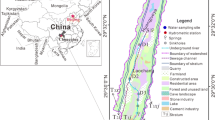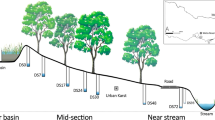Abstract
One-way floodgates installed on flood mitigation drains in regions affected by acid sulphate soils restrict carbonate/bicarbonate buffering, thereby creating reservoirs of acid water (pH < 4.5) that discharge during the ebb tide. The drain water quality and hydrodynamic conditions prior to and following floodgate modifications that allowed for controlled saline intrusion are described with reference to data collected from intensively drained and floodgated coastal lowlands located in southeastern New South Wales, Australia. Cl:SO4 ratios taken from groundwater samples depicted an acidic environment with little soil buffering capacity. Prior to modification, water quality upstream of the one-way floodgate was consistently acidic (average pH 4.6) with high concentrations of aluminum and iron that fluctuated with precipitation. Over a two-week period before modifications, floodgate leakage permitted alkaline water to intrude upstream of the floodgate and react with H+ ions. This period showed the strongest supporting field evidence for tidal buffering via modified floodgates. After installing vertical lifting, two-way floodgates average drain water pH increased to 5.89 and aluminum and iron concentrations decreased by more than 30%. A large rainfall (131.8 mm) during the post-modification period caused acidic groundwater flushing, however, in comparison to the pre-modification period, recovery time and average pH were markedly improved. Preliminary investigations of groundwater salinity in response to tidal intrusion has shown that electrical conductivity fluctuates with rainfall and it is predominately limited to 10 m perpendicular to the drain.
Similar content being viewed by others
References
APHA (1985) Standard methods for the examination of water and wastewater, 16th Edn, American Public Health Association, Washington DC.
ANZECC (1992) Australian Water Quality Guidelines for Fresh and Marine Waters, Australian and New Zealand Environment Conservation Council Press, Canberra.
Blunden, B. G. (2000) Management of Acid Sulfate Soils by GroundwaterManipulation. PhD Thesis, University of Wollongong, NSW Australia.
Blunden, B. and Indraratna, B. (2001) Pyrite oxidation model for assessing groundwater management strategies in acid sulfate soils, Journal of Geotechnical and Geo-Environmental Engineering—American Society of Civil Engineering, 127(2), 146-157.
Callinan, R. B., Paclibre, J. O., Reantaso, M. B., Lumanlan-Mayo, S. C., Fraser, G. C. and Sammut, J. (1995) EUS outbreaks in estuarine ¢sh in Australia and the Philippines: associations with acid sulphate soils, and rainfall, and Aphanomyces. In Diseases in Asian Aquaculture II. Shariff, M., Arthur, J. R. and Subasinghe, R. P. (eds), Fish Health Section, Asian Fisheries Society, Manilla, pp. 291-298.
Chapman, S. J. (1994) Development of a strategy for the management of acid sulfate soils in Berry, NSW. Honours thesis for Bachelor of Engineering, Department of Civil and Mining Engineering, University of Wollongong, Australia.
Davies M. and Mumby, B. (1999) Acid sulfate soil management priority areas in the Shoalhaven £oodplain6Broughton Creek. Department of Land and Water Conservation, Sydney.
Ferguson, A. and Eyre, B. D. (1996) Floodplain hydrology and the transport of acid sulfate soil products. In Proceedings of 2nd National Conference on Acid Sulfate Soils, Coffs Harbour, 5-6 September 1996, Smith, R. J. and Smith, H. J. (eds), pp. 120-127.
Flemming, W. G. K., Weltman, A. J., Randolph, M. F. and Elson, W. K. (1992) Piling Engineering, Blackie and Son, Ltd., London.
Jones, B. F., Vengosh, A., Rosenthal, E. and Yechieli, Y. (1999) Seawater Intrusion in Coastal Aquifers6Concepts, Methods and Practices, Bear, J., Cheng, A. H. D., Sorek, S., Ouazar, D., and Herrera, I. (eds), Kluwer Academic Publishers, London.
Mulvey, P. (1993) Pollution, prevention and management of sulfuric clays and sands, In Proceedings of National Conference on Acid Sulfate Soils, Coolangatta, 24-25 June 1993, Bush, R. (ed.), pp. 116-129.
Nethery, A., Jamieson, P. and Downey, J. (1996) Shoalhaven River Project, In Proceedings of 2nd National Conference on Acid Sulfate Soils, Coffs Harbour, 5-6 September 1996, Smith, R. J. and Smith, H. J. (eds), pp. 89-91.
Pease, M. (1994) Acid Sulfate Soils and acid drainage—Lower Shoalhaven £oodplain, NSW. MSc (Hons) thesis, University of Wollongong, NSW Australia.
Raymond, G. E. and Higginson, F. R. (1992) Australian Handbook of Soil and Water Chemical Methods. Inkata Press. Melbourne, Australia.
Roy, P. S., Thom, B. G. and Wright, L. D. (1980) Holocene sequences on an embayed high-energy coast: an evolutionary model. Sedimentary Geology, 26, 1-19.
Sammut, J. (2000) A Introduction to Acid Sulfate Soils. Information booklet published through Natural Heritage Trust. Sydney, Australia.
Sammut, J., White, I. and Melville, M. D. (1994) Stratification in acidified coastal fl oodplain drains. Wetlands (Australia), 13, 49-64.
Sbeghen, B. (1995) Acid sulfate soils in the Berry region, NSW—Baseline studies and preliminary assessment of management options. Honours thesis for Master of Environmental Science, Faculty of Science, University of Wollongong, Australia.
Sharman, S. M. (1995) A study on Acid sulfate soils found on agricultural land on the Broughton Creek Floodplain, Berry NSW. Honours thesis for Bachelor of Environmental Science, Faculty of Science, University of Wollongong, Australia.
Stumm, W. and Morgan, J. J. (1996) Aquatic Chemistry, 3rd Edn, John Wiley and Sons, New York.
Sutherland, N.M., Scott, P. A. and Morton, W.K. (1996) Field practicalities of treating acid sulfate soils. In Proceedings of 2nd National Conference on Acid Sulfate Soils, Coffs Harbour, 5-6 September 1996, Smith, R. J. and Smith, H. J. (eds), pp. 221-224.
White, I., Melville, M., Sammut, J. and Wilson, B. (1997) Reducing acidic discharges from coastal wetlands in eastern Australia. Wetlands Ecology and Management, 5, 55-72.
White, I. (1996) Possible Impacts of saline water intrusion £oodgates in Vietnam's lower Mekong delta. In Proceedings of Seminar on Environmental and Development in Vietnam, 6-7 December, Canberra.
Wilson, B. P. (1995) Soil and Hydrological relations to drainage from sugarcane on acid sulphate soils. PhD Thesis, University of New South Wales, Sydney.
Author information
Authors and Affiliations
Rights and permissions
About this article
Cite this article
Indraratna, B., Glamore, W.C. & Tularam, G.A. The effects of tidal buffering on acid sulphate soil environments in coastal areas of New South Wales. Geotechnical and Geological Engineering 20, 181–199 (2002). https://doi.org/10.1023/A:1016075026487
Issue Date:
DOI: https://doi.org/10.1023/A:1016075026487




